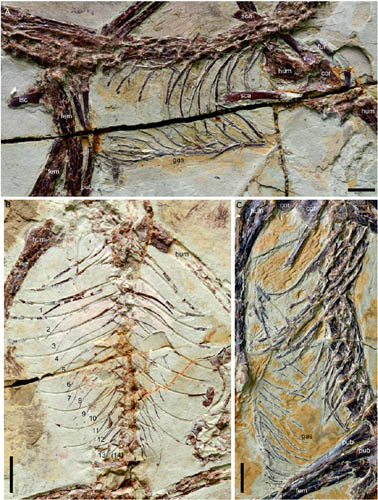| Location: Home > Research > Research Progress |
| Scientists Reveal the Complex Early Evolution of the Bird’s ‘Breastbone’ |
|
It has always been difficult to understand how birds evolved from dinosaurs because of the strange combination of features observed in taxa inferred to be situated near this great evolutionary transition. For example, the sternum, also called the 'breastbone', is a large bone to which the lower ends of the bird's ribs are attached. It is intrinsic to modern avian flight, providing the attachment surface for the two largest muscles in the body, the primary fight muscles the pectoralis and supracoracoideus. This bone is present in many dinosaurs inferred to be closely related to birds (e.g. Microraptor, Epidexipteryx) and most basal birds (e.g. Confuciusornis, enantiornithines) but strangely is absent in troodontid dinosaurs and the early birds Archaeopteryx and Sapeornis. In a paper published online before print September 08 in the Proceedings of the National Academy of Sciences, scientists from the Institute of Vertebrate Paleontology and Paleoanthropology of the Chinese Academy of Sciences (IVPP), and Shandong Tianyu Museum of Nature (STM) observed more than 200 specimens of Anchiornis, the earliest known feathered dinosaur, and nearly 100 specimens of Sapeornis, one of the basalmost birds, and recognized no sternal ossifications. They proposed that the sternum may have been completely lost in these two taxa (and Archaeopteryx as well) based on histological analysis and the excellent preservation of soft-tissue structures, thus revealing an unexpected level of complexity and high degree of inherent developmental plasticity in the early evolution of the avian sternum. With only a few published specimens of each taxon previously available (11 Archaeopteryx; three Anchiornis; ten Sapeornis), the absence of a sternum remained equivocal. This thin element could be missing due to poor preservation or have yet to ossify in ontogenetically immature specimens, both valid alternative scenarios for the perceived absence of this element. Researchers employed histological analysis to study the microstructure of bones in large specimens of Anchiornis and Sapeornis in order to confirm that they represent adults and rule out the possibility that the sternum is absent only because available specimens are not adults; in light of the huge number of specimens (96 Sapeornis), a preservational bias can further be ruled out. Thus searchers argue that a bony sternum can now be definitively considered absent in Anchiornis and Sapeornis. Furthermore, many of the specimens in the collection are exceptionally well preserved with soft tissue such as feathers. Researchers suggest that this indicates a cartilaginous sternum was also not present. Based on the phylogenetic position of Archaeopteryx and its morphological similarity to troodontids, researchers further suggest that a cartilaginous sternum was also absent in this iconic taxon. Although this is at odds with scientific inferences from flight in modern birds, this study further reveals the high degree of evolutionary complexity that characterizes the dinosaur-avian transition and highlights the continued ability of new discoveries to go beyond our expectations. Fossils are rare and extinct taxa are typically poorly known from small numbers of often poorly preserved and very incomplete specimens. However, the prolific Middle to Late Jurassic Daohugou and Early Cretaceous Jehol deposits in northeastern China are unique in the global fossil record in that they have yielded in some cases hundreds of specimens of a single taxon, most of which are largely complete, articulated, and well preserved, sometimes even boasting exceptional biological traces rarely recorded by the fossil record such as soft tissue such as feathers and stomach contents. The single greatest collection of Daohugou and Jehol specimens provides a unique academic environment in which many typically elusive aspects of extinct animal biology can be studied. This research was supported by National Basic Research Program of China 973, National Natural Science Foundation of China, and the Chinese Academy of Sciences.  Fig. 1. Three specimens of Anchiornis sp. preserving the complete or nearly complete gastral basket but no sternal ossifications including sternal ribs, Scale bars equal 1 cm. (Image by ZHOU Zhonghe) |